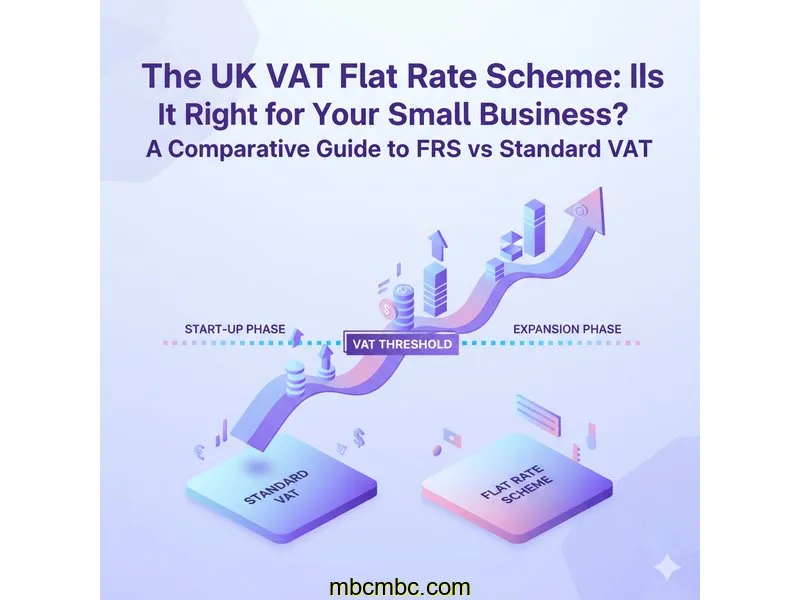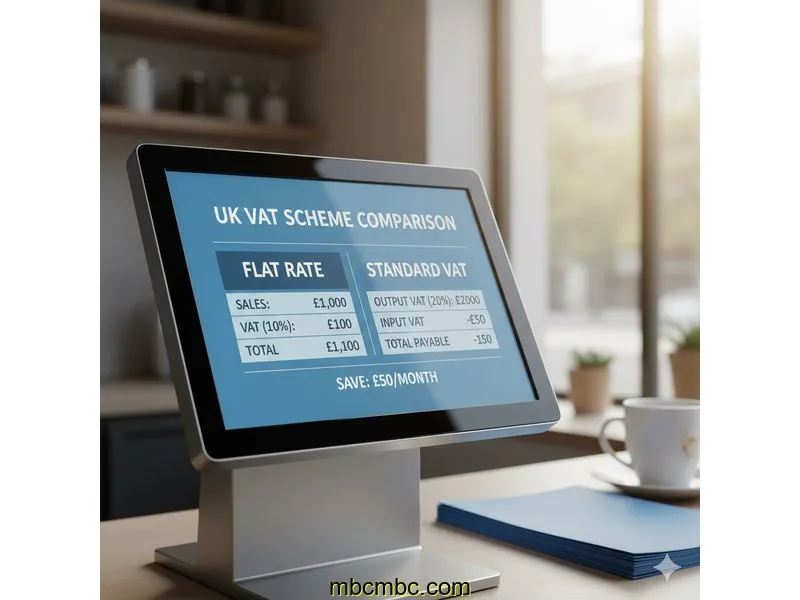
Hi, I'm Alex from FinTools UK. Dealing with VAT can feel like navigating a maze, especially when you’re a small business owner trying to focus on growth, not paperwork. Once your turnover hits the threshold—or you choose to register early—you face a key decision: **Standard VAT Accounting** or the **Flat Rate Scheme (FRS)**.
The FRS was designed by HMRC to simplify things, trading complexity for a slightly higher effective VAT rate. But "simple" doesn't always mean "better" for your bottom line. The key is understanding how your business structure—specifically, your cost base—interacts with the FRS's fixed-rate model. In this guide, we’ll break down this critical choice, look at the potential financial impact, and help you determine which approach genuinely saves you time without costing you too much money.
Quick Summary: FRS vs. Standard VAT
- Standard VAT: You charge 20% VAT on sales (Output VAT) and reclaim 20% VAT on purchases (Input VAT). You pay the difference to HMRC. Best for businesses with high VAT-able expenses.
- Flat Rate Scheme (FRS): You charge 20% VAT on sales (Output VAT), but you pay HMRC a fixed percentage of your total gross (VAT-inclusive) turnover. You **cannot** reclaim Input VAT on most purchases. Best for service-based businesses with very low VAT-able expenses.
- The Critical Rule: The **Limited Cost Business (LCB)** rule. If your annual VAT-inclusive expenditure on goods is less than 2% of your VAT-inclusive turnover, or less than £1,000 (if turnover is over £50,000), you must use the 16.5% rate. This often makes FRS financially unviable, as noted by many accountants.
How the Flat Rate Scheme Works: Simplicity at a Price
The core concept of the FRS is brilliantly simple: you charge customers the standard 20% VAT, but when it’s time to pay HMRC, you only send a lower, fixed percentage of your **gross turnover** (sales plus VAT). You get to keep the difference, which is your compensation for not having to track and claim Input VAT on the vast majority of your purchases.
Think of it like an all-inclusive holiday package versus pay-as-you-go. With Standard VAT, you itemise every meal and activity (Input VAT) and claim it back. With FRS, you pay a fixed, lower amount upfront (the flat rate percentage) and enjoy simplicity, but you forfeit your right to claim back individual costs. The fixed rate you pay depends on your industry—a small IT consultancy, for example, might use a 14.5% rate, whereas a retail business would have a different rate.
There are two key factors that make FRS attractive for qualifying small businesses. First, a major benefit is the **1% FRS Discount**. If you are in your first year of VAT registration, you automatically qualify for a **1% reduction** on your flat rate percentage. So, a 14.5% rate becomes 13.5% for the first 12 months. Second, the FRS provides a massive reduction in bookkeeping complexity, freeing up valuable time.
The Limited Cost Business Rule: The FRS Dealbreaker
The biggest complication in the FRS, and the rule that has made it less appealing for many, is the **Limited Cost Business (LCB)** test. This was introduced to stop businesses with virtually no costs from abusing the scheme. You are classed as an LCB if your spending on 'relevant goods' is:
- Less than **2%** of your VAT-inclusive turnover in a reporting period, **OR**
- Greater than 2% of turnover, but less than **£1,000** per year (pro-rata for shorter periods).
If you meet this LCB definition, your flat rate percentage is automatically increased to **16.5%**, regardless of your industry. For many service-based businesses, this 16.5% rate makes the FRS financially worse than the Standard VAT scheme, especially when considering the time-saving benefit often doesn't offset the increased tax cost. The most recent public HMRC statistics show that LCB confusion is one of the most common reasons for errors in FRS submissions.
Comparing the Costs: FRS vs. Standard VAT Scenario Breakdown
To really see the difference, it helps to look at a few common small business scenarios. The table below compares the final VAT liability for a first-year IT consultant with low expenses (Scenario A) versus a web design agency with higher software and contractor costs (Scenario B). Note how the LCB rule completely changes the result for the IT consultant.
| Scenario Detail | Annual Turnover (£ Net) | Annual VAT-able Expenses (£ Net) | Standard VAT Net Paid to HMRC | FRS Net Paid to HMRC (13.5% Rate) | FRS Net Paid to HMRC (16.5% LCB Rate) |
|---|---|---|---|---|---|
| A: Low Cost IT Freelancer (LCB) | £60,000 | £800 | £11,840 | £9,720 (First Year Rate, but LCB applies) | £11,880 (LCB applies) |
| B: High Cost Web Agency (Not LCB) | £100,000 | £15,000 | £17,000 | £16,200 (First Year Rate) | N/A |
Note:
*FRS rates used are the First Year Discounted rate (1% off 14.5% for IT/Consultancy).
*Scenario A's expense is less than 2% of their £72,000 gross turnover, forcing the 16.5% LCB rate, which is more expensive than Standard VAT.
*Scenario B's expense is high enough that they avoid the LCB rate, making the FRS financially beneficial in the first year.
How Calculators Help Understand the Flat Rate Scheme
It's easy to look at the fixed percentages and assume a quick answer, but the interplay between your industry rate, the 1% discount, and especially the **Limited Cost Business test** makes a simple calculator indispensable. Instead of guessing, a well-designed tool will:
- **Flag LCB Status:** Automatically calculate whether your expenses meet the 2% / £1,000 threshold based on the figures you input.
- **Compare Net Savings:** Show a clear line-by-line comparison of your net payment to HMRC under Standard VAT vs. FRS, revealing which option genuinely saves you money (or costs you more) after accounting for the forfeited Input VAT.
- **Factor in Discounts:** Accurately apply the 1% first-year discount if you're a new registrant, providing a true picture of the initial benefit.
Common Questions About the VAT Flat Rate Scheme

Here are answers to some of the specific, real-world questions that small business owners often struggle with when considering the Flat Rate Scheme.
What happens if I forget to leave the FRS when I become a Limited Cost Business?
If you mistakenly use your lower industry rate (e.g., 14.5%) when you should be using the 16.5% LCB rate, you will underpay your VAT. HMRC will eventually discover this via a compliance check and require you to pay the difference, along with potential penalty charges and interest on the late payment. You must re-test for the LCB status at the start of every new accounting period.
If I use the FRS, can I still claim VAT on a single large asset purchase?
Yes, the FRS has a specific exception for capital assets. You can still claim the Input VAT back on the purchase of a single capital asset if its VAT-inclusive price is £2,000 or more. This is an important relief for businesses making large, infrequent purchases like expensive machinery or a company vehicle.
Does the FRS first-year discount apply even if I register voluntarily?
Yes, the 1% reduction on your flat rate percentage applies for the first 12 months from the date your business first registers for VAT, regardless of whether you registered voluntarily before hitting the mandatory threshold or registered because you were required to do so.
Final Thoughts
The Flat Rate Scheme is a genuine simplification tool, and for the right type of business—typically a service provider with low VAT-able expenditure that avoids the 16.5% LCB rate—it can offer both a time-saving benefit and a slight financial advantage, especially in the first year. However, it is not a universally good option.
Your decision must be an informed, calculated one based on your specific figures. If your VAT-able costs are significant, or if the LCB rule applies to you, the Standard VAT method will almost certainly be the better financial choice. Always check your calculations annually, especially as your business grows and your expense profile changes.

